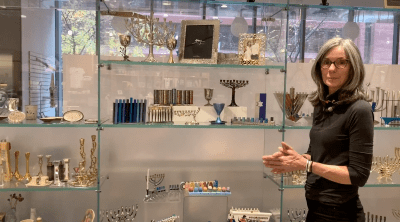Though its physical doors have been closed since March 2020, the National Museum of American Jewish History has swung its virtual doors wide open, embracing opportunities to sell merchandise, expand programming, and raise funds online. Photo credit: Courtesy of the National Museum of American Jewish History.
Dr. Misha Galperin, Thriving as a Virtual Museum: The National Museum of American Jewish History’s Playbook, American Alliance of Museums, 2 April 2021
Like many museums, the National Museum of American Jewish History (NMAJH)’s doors have remained closed to the public since March 2020. Our physical doors, that is. Our museum is very much open through virtual offerings—and we’re happy to report that we are thriving.
We continue to connect with our audiences through public programming that now reaches more people than ever before. We’re making headlines with our timely and creative museum store merchandise. We raised 830 thousand dollars through an all-virtual fundraising gala. And we are introducing new audiences to our collections through virtual tours and customized virtual group programs.
Though we, like many of our peer institutions, had to reduce staff during the pandemic, we’ve managed not only to maintain but to grow a solid presence locally, nationally, and even internationally with a staff of just twelve (and, of course, an engaged, supportive board of trustees and volunteer corps).
It hasn’t been easy, and it’s constantly an uphill battle, but in the following sections, I’ll address the specifics of how we’ve done it. First, I’ll share some background about our museum:
Established in 1976, and situated on Philadelphia’s Independence Mall, the National Museum of American Jewish History is the only museum in the nation dedicated exclusively to exploring and interpreting the American Jewish experience. Our museum takes the many important and complicated conversations about American freedom happening across the Mall and explores them through the lived experience of a religious minority in this country. NMAJH presents educational programs and experiences that preserve, explore, and celebrate the history of Jews in America. Its purpose is to connect Jews more closely to their heritage and to inspire in people of all backgrounds a greater appreciation for the diversity of the American Jewish experience and the freedoms to which Americans aspire.
Boosting the Store
We have always been fortunate to have a popular museum store that sells a mix of ritual items, pop culture merchandise, elegant jewelry, kid-friendly products, and more. Since the pandemic began, however, the store has shifted from being just one component of our budget to the primary source of earned revenue for the museum. And so we doubled down.
The store—which previously made 80 percent of its revenue through in-person sales—quickly shifted to 100 percent e-commerce. It now sells all of its approximately thirty-five hundred items online and ships throughout the US and Canada. We are pacing 60 percent ahead of sales compared to last year and 235 percent compared to two years ago. How?

People: Our Director of Retail and Visitor Experience, Kristen Kreider, brings her decades of retail experience to the table—she owned and ran boutique retail establishments in Philadelphia for twenty years. Kristen keeps her eye on trends and does all of the buying for the store, sources fabric, works on designs, customizes items, and commissions new pieces, like this Statue of Liberty face mask.
Merchandise: We’ve always featured pop culture merchandise, such as RBG-themed items, in our store. This year, we added timely collectibles like our limited edition “Mamala Harris” shirt and Dr. Fauci tote bags. For the Jewish holidays, we shifted our focus from the usual host gifts to items for all those who were unable to visit relatives and celebrating on their own for the first time. For example, we offered Seder plates, which many Jews have had to purchase for a socially distant Passover.

Art: The store’s staff of two photographed hundreds of items to build out our online store and create imagery for the social media marketing that has been so critical to our retail growth. They continue to add photos of new items regularly to improve the online shopping experience.
Marketing: Even with razor-thin margins, we knew a dedicated investment in digital marketing for retail was critical. Our paid advertising through Facebook and Google drives nearly 50 percent of our total store sales, and we consistently see a return of more than four times our investment, often much higher. Regular email to our loyal customers always directly correlates to sales, and employing best retail practices such as encouraging small add-on purchases at checkout and implementing abandoned cart email flows ensures we don’t leave any money on the table.

Luck: Call it being in the right place at the right time or the natural result of hard work, but we’ve been fortunate to twice be poised to capitalize on the zeitgeist of 2020.
In August 2020, when President Trump mispronounced Yosemite National Park as “Yo Semite,” we thought immediately of the Yo Semite shirts that had been a staple in our store since 2011. We launched a new digital marketing campaign to sell the shirts in this new context, which generated press coverage nationwide. Kristen quickly got permission from the shirt’s designer to have them screen-printed right here in Philly so we’d be able to meet demand.
We’ve sold about eleven thousand Yo Semite shirts since then. Our small but mighty staff came in to help process orders, from stuffing and taping boxes to handwriting personalized gift messages. The shirts have been covered in 267 news stories for a total of more than 462 million media impressions in print, broadcast, and online outlets—from CNN to wire services to Jewish-interest publications.

A second opportunity presented itself when the meme of Senator Bernie Sanders at the Inauguration ceremony took the internet by storm. We quickly created “Bundled Up Bernie” mugs and t-shirts showing the Jewish Senator from Vermont keeping warm in his winter coat and wool mittens on the Capitol steps. In a matter of days, we had sold more than nine hundred mugs and three hundred shirts. We generated three hundred thousand media impressions in the Philadelphia market and a national radio story.
Prioritizing Programming
Since public programs have always been at the heart of NMAJH’s work, we took our programming online in April 2020. Since then, we’ve produced more than two dozen virtual events, such as concerts and discussions, with impressive results and significant growth across key online and social media metrics, and engaged in another two dozen partnerships.
Highlights of our virtual events have included a livestream conversation with actress Mayim Bialik, a concert in honor of legendary Ladino (Judeo-Spanish) musician Flory Jagoda, and an inclusive family-friendly event on Christmas Day.
Since the beginning of the pandemic, we’ve increased our total estimated reach on Facebook by 82 percent and website page views by 280 percent. For those of you data wonks: our average per-livestream reach is just under forty thousand; our average viewership (peak live views, one-minute views, landing page views, and Zoom views) is twenty-four hundred—a 126 percent increase; our average three-second views are twenty-one thousand—a 183 percent increase; and our average engagement is seventeen hundred—a 60 percent increase. What that means in plain terms is that now, a minimum of twenty-four hundred people from all around the country and world tune in for each virtual program on average, whereas past in-person events could only accommodate about 230 people. And we reach tens of thousands of people more than our localized targeted advertising had garnered previously. We continue to foster opportunities for real-time engagement through comments, chat, and question & answer sessions to provide as much of that “in-the-room” spirit as we can.
While online programming is different from an in-person experience, we now reach approximately the same number of people with each livestream program that we reached with in-person programs during the entire nine years prior.
We’re constantly evaluating our metrics and determining how best to assess progress and grow our audience. While most of our programs are free with no registration barrier, we recently implemented a low-barrier email collection system to accompany our programs, since our database is a critical asset and it’s important we understand who is participating. We have collected four hundred additional email addresses since we added this new feature in February 2021, and anticipate collecting an additional three thousand records through this method by the end of the fiscal year. Additionally, we have increased our overall subscriber list by approximately 23 percent during the past year, primarily driven by program opportunities and encouraging sign-ups to keep informed.

